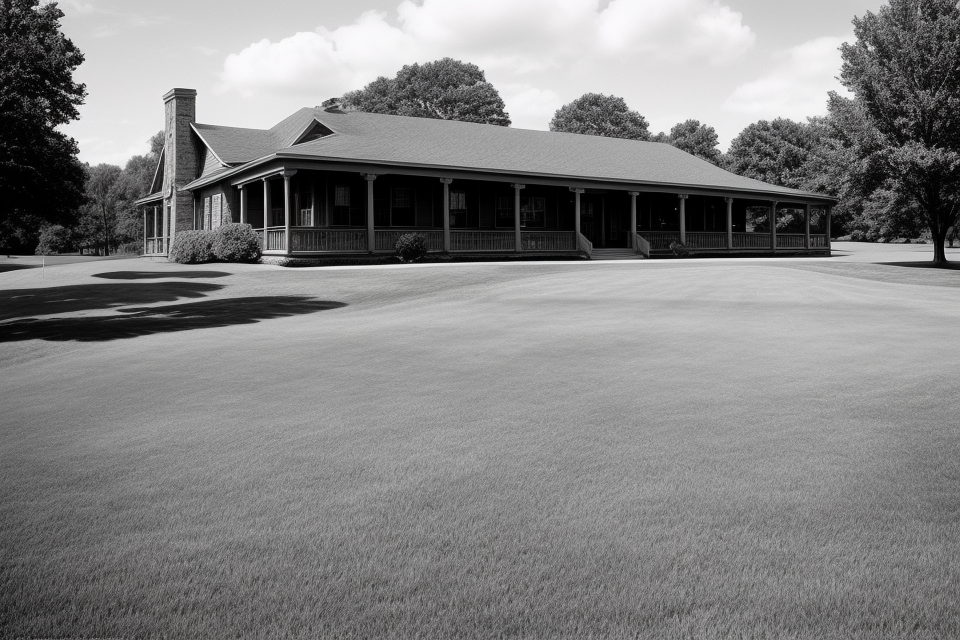
In today’s digital age, it’s easy to assume that traditional advertising methods like those found on golf courses are a thing of the past. But, is this really the case? Despite the rise of digital marketing, advertising on golf courses remains a relevant and effective strategy for businesses looking to reach their target audience. From the high visibility of golf course signage to the captive audience of golfers, there are many benefits to be gained from advertising on this unique platform. In this article, we’ll explore the relevance of golf course advertising in the digital age and why it should still be considered as part of your marketing mix.
Advertising on golf courses can still be a relevant strategy in the digital age, as golfers are often a desirable demographic for businesses. However, it is important to note that the digital age has changed the way people consume media, and businesses need to be strategic in their advertising efforts. Incorporating digital advertising, such as social media and targeted online ads, alongside traditional golf course advertising can help reach a wider audience and maximize the impact of advertising efforts. Ultimately, the success of advertising on golf courses in the digital age will depend on the specific business and its target audience.
The Benefits of Advertising on Golf Courses
Reaching a Targeted Audience
Demographics of Golf Course Visitors
Advertising on golf courses can provide a unique opportunity for businesses to reach a targeted audience. Golf courses attract a diverse range of visitors, including business professionals, high-net-worth individuals, and retirees. By advertising on golf courses, businesses can reach individuals who have the disposable income to make purchasing decisions, and who may be interested in their products or services.
Advertising to High-Net-Worth Individuals
Golf courses are often frequented by high-net-worth individuals, who have the financial resources to make significant purchases. Advertising on golf courses can provide businesses with an opportunity to reach this affluent demographic, and to promote their products or services to individuals who may be interested in luxury items or high-end services.
Furthermore, golf courses are often located in upscale neighborhoods or in areas with a high concentration of businesses. This means that advertising on golf courses can provide businesses with exposure to individuals who may be interested in their products or services, and who may be in a position to make purchasing decisions.
In addition, golf courses often have a reputation for being exclusive and prestigious. By advertising on golf courses, businesses can associate themselves with this prestige and exclusivity, and can leverage the positive perceptions that come with it. This can be particularly beneficial for businesses that are looking to build their brand and establish themselves as a premium provider in their industry.
Overall, advertising on golf courses can provide businesses with a unique opportunity to reach a targeted audience of high-net-worth individuals and other affluent demographics. By leveraging the demographics of golf course visitors and the prestige of golf courses, businesses can effectively promote their products or services and build their brand in the digital age.
Building Brand Awareness
Golf Course Signage and Exposure
One of the primary benefits of advertising on golf courses is the opportunity to increase brand awareness through signage and exposure. Golf courses offer ample space for signage, such as banners, billboards, and tee signs, which can display your company’s logo, products, and services. These signs are prominently displayed throughout the course, providing repeated exposure to both players and spectators, helping to reinforce your brand and create a strong visual identity.
Sponsorship Opportunities
Another way to build brand awareness through golf course advertising is by sponsoring events or holes. This can include tournaments, charity events, or even individual holes, where your company’s name or logo is prominently displayed on the signage or mentioned in promotional materials. Sponsorship opportunities not only provide exposure to a captive audience but also allow you to associate your brand with a desirable and respected event or location. This can help to enhance your brand’s reputation and create a positive image among golf enthusiasts and other stakeholders.
In addition to these direct branding opportunities, advertising on golf courses can also provide indirect exposure through the demographics of the sport’s participants and spectators. Golf is often associated with affluent individuals and corporations, making it an attractive target for companies looking to reach high-net-worth consumers. By advertising on golf courses, you can tap into this audience and increase the visibility of your brand among the decision-makers and influencers who frequent these venues.
Moreover, golf courses often attract a loyal and engaged audience, with many players returning regularly to enjoy the course and network with other players. This consistent exposure to your brand can help to foster familiarity and trust among potential customers, increasing the likelihood that they will consider your products or services when making purchasing decisions.
Overall, advertising on golf courses remains a relevant strategy in the digital age due to the unique opportunities it provides for building brand awareness through signage and exposure, sponsorship opportunities, and access to a desirable and engaged audience.
Measuring the ROI of Golf Course Advertising
When it comes to measuring the return on investment (ROI) of golf course advertising, there are several key metrics that businesses should track. These include:
Tracking Sales and Leads
One of the most direct ways to measure the effectiveness of golf course advertising is by tracking sales and leads generated as a result of the advertising efforts. This can be done by analyzing data on the number of new customers acquired through the golf course advertising campaign, as well as the revenue generated by these new customers. By comparing this data to the cost of the advertising campaign, businesses can determine the overall ROI of their golf course advertising efforts.
Monitoring Brand Awareness
In addition to tracking sales and leads, businesses should also monitor changes in brand awareness as a result of their golf course advertising efforts. This can be done by conducting pre- and post-campaign surveys to gauge changes in brand recognition and recall among golf course patrons. By tracking changes in brand awareness, businesses can determine the overall effectiveness of their golf course advertising efforts in building brand recognition and loyalty.
Overall, measuring the ROI of golf course advertising requires a careful analysis of both sales and leads generated, as well as changes in brand awareness among golf course patrons. By tracking these key metrics, businesses can determine the overall effectiveness of their golf course advertising efforts and make informed decisions about how to allocate their advertising budgets in the future.
The Evolution of Golf Course Advertising
The Shift to Digital Advertising
As technology continues to advance, businesses are increasingly shifting their advertising efforts from traditional media to digital platforms. This shift has also impacted the way companies advertise on golf courses. In the past, businesses would place banners and signs on the course, but now they are turning to digital advertising to reach their target audience.
Targeted Digital Advertising
One of the benefits of digital advertising is the ability to target specific audiences. Golf courses can use data on their customers, such as age, gender, and income, to create targeted ads that are more likely to reach the right people. For example, a golf course may use targeted digital advertising to promote a new membership package to affluent golfers in a specific age range.
Influencer Marketing
Another digital advertising strategy that is becoming increasingly popular is influencer marketing. This involves partnering with social media influencers who have a large following in the golf industry to promote the golf course and its offerings. For example, a golf course may partner with a professional golfer or golf blogger to promote a new tournament or event. Influencer marketing can be an effective way to reach a wider audience and build brand awareness.
However, despite the benefits of digital advertising, some businesses still prefer traditional advertising methods. For example, some may feel that physical signs and banners provide a more tangible presence on the golf course. Additionally, some golf courses may not have the resources or expertise to create and execute digital advertising campaigns. As a result, a combination of traditional and digital advertising strategies may be the most effective way to reach a wide range of potential customers.
Integrating Technology into Golf Course Advertising
Golf courses have always been a popular platform for advertising, with companies utilizing banners, signs, and other traditional methods to reach their target audience. However, with the rise of digital technology, golf course advertising has also evolved to incorporate new and innovative methods that can provide greater engagement and interaction with golfers.
Mobile Apps and QR Codes
One of the most effective ways of integrating technology into golf course advertising is through the use of mobile apps and QR codes. Many golf courses now offer their own mobile app, which can be used to provide players with information about the course, such as hole-by-hole descriptions, scorecards, and course maps. These apps can also be used to provide players with offers and promotions from local businesses, such as restaurants and hotels, which can help to increase foot traffic and revenue for these businesses.
QR codes are another effective way of integrating technology into golf course advertising. These codes can be placed on signs, banners, and other advertising materials, and can be scanned by players using their smartphones. This allows players to access additional information about the advertiser, such as product details and contact information, as well as special offers and promotions.
Interactive Displays and Signage
In addition to mobile apps and QR codes, golf courses can also use interactive displays and signage to enhance their advertising efforts. These displays can be used to provide players with information about the course, as well as to showcase the products and services of local businesses. Interactive displays can include touchscreens, virtual reality experiences, and other engaging technologies that can help to capture the attention of players and keep them engaged with the advertising message.
Overall, integrating technology into golf course advertising can provide a number of benefits for both golf courses and advertisers. By leveraging the power of mobile apps, QR codes, and interactive displays, golf courses can provide a more engaging and interactive experience for players, while advertisers can reach a highly targeted and engaged audience in a unique and memorable way.
The Future of Golf Course Advertising
Emphasizing Sustainability and Corporate Social Responsibility
Eco-Friendly Advertising Materials
As environmental concerns continue to grow, golf course advertisers are shifting towards eco-friendly advertising materials. This trend involves the use of sustainable materials that are biodegradable, recyclable, or energy-efficient. Some examples include solar-powered advertising displays, banners made from recycled materials, and digital signage that consumes less energy compared to traditional screens. By embracing eco-friendly advertising materials, golf course advertisers can demonstrate their commitment to reducing their carbon footprint and promote environmentally responsible practices.
Community Outreach and Sponsorships
Golf courses often serve as important community hubs, providing opportunities for local residents to engage in sports and recreation. As such, golf course advertisers are increasingly focusing on community outreach and sponsorships as part of their marketing strategies. This approach involves partnering with local schools, charities, and community organizations to support causes that resonate with their target audience. By doing so, advertisers can build positive brand associations and strengthen their connections with the local community. Moreover, these partnerships often provide opportunities for brand exposure through event sponsorships, signage, and other promotional activities, thereby amplifying the impact of their advertising efforts.
The Rise of Virtual Reality and Augmented Reality Advertising
With the rapid advancement of technology, virtual reality (VR) and augmented reality (AR) are increasingly being used as innovative advertising tools in the golf industry. These immersive technologies are creating new opportunities for brands to engage with golf enthusiasts and reach a wider audience.
Immersive Brand Experiences
Golf courses are incorporating VR and AR technologies to provide unique brand experiences for golfers. For example, some courses are using VR to create simulated environments that allow golfers to practice their swings or play virtual rounds on famous courses from around the world. Brands can partner with these courses to sponsor these virtual experiences, providing exposure to a captive audience of golfers.
Furthermore, AR technology is being used to enhance the golfing experience by providing real-time information, such as distances to the green or wind speed, through a mobile app. This technology can be utilized by golf courses to offer a more interactive and engaging experience for golfers, while also providing opportunities for brands to integrate their products or services into the app.
Data-Driven Advertising
The integration of VR and AR technologies in golf courses also provides valuable data on the behavior and preferences of golfers. By tracking the movements and interactions of golfers with VR and AR technologies, golf courses can gather data on consumer behavior, such as which virtual experiences are most popular or which brands are most engaging. This data can be used by brands to tailor their advertising strategies and better target their audience.
Moreover, the data collected can be used to create more personalized and relevant advertising experiences for golfers. For instance, brands can use the data to send targeted advertisements to golfers based on their interests or preferences, increasing the likelihood of conversion.
In conclusion, the rise of VR and AR technologies in golf courses presents new opportunities for brands to engage with golfers and reach a wider audience. By partnering with golf courses to sponsor virtual experiences or integrating their products into mobile apps, brands can provide immersive and engaging brand experiences for golfers. Additionally, the data collected through these technologies can be used to create more personalized and targeted advertising strategies, enhancing the effectiveness of advertising efforts on golf courses.
The Enduring Value of Golf Course Advertising
Building Relationships with Customers
Golf course advertising is an effective way for businesses to build long-term relationships with their customers. Golfers often spend several hours on the course, which provides ample opportunity for businesses to engage with them through signage, banners, and other promotional materials. By consistently exposing customers to their brand, businesses can create a positive image and establish themselves as a trusted partner. This can lead to increased loyalty and repeat business, which is especially valuable in today’s competitive marketplace.
Staying Ahead of the Competition
Golf courses are popular venues for corporate events and networking, making them an attractive advertising platform for businesses looking to reach high-end customers. By advertising on golf courses, businesses can position themselves as industry leaders and gain a competitive edge over their rivals. Additionally, golf courses often attract a diverse range of customers, including decision-makers and influencers, making them an ideal platform for businesses looking to reach a broad audience.
The Importance of Strategic Planning and Measurement
Effective golf course advertising requires strategic planning and measurement to ensure that businesses are getting the most out of their investment. This includes identifying the target audience, selecting the most effective advertising channels, and measuring the success of the campaign. By tracking metrics such as website traffic, social media engagement, and sales, businesses can adjust their advertising strategy to maximize their ROI and achieve their marketing goals.
FAQs
1. Is advertising on golf courses still a relevant strategy in the digital age?
Yes, advertising on golf courses is still a relevant strategy in the digital age. While digital advertising has become more prevalent, golf courses still offer a unique opportunity to reach a targeted audience. Golfers are often high-income individuals with disposable income, making them an attractive demographic for advertisers. Additionally, golf courses often have signage and other advertising opportunities that can’t be found in the digital space.
2. What are the benefits of advertising on a golf course?
The benefits of advertising on a golf course include reaching a targeted audience, building brand awareness, and generating leads. Golf courses often have a captive audience of high-income individuals who are receptive to advertising messages. Advertising on a golf course also allows businesses to build brand awareness and generate leads by putting their products and services in front of potential customers.
3. How does advertising on a golf course compare to digital advertising?
Advertising on a golf course and digital advertising are two different strategies that can complement each other. While digital advertising offers a wider reach and more precise targeting, golf course advertising offers a more personal and engaging experience for consumers. Golf courses provide opportunities for businesses to engage with customers in person, such as through sponsorships and event advertising, which can’t be replicated in the digital space.
4. What types of businesses should consider advertising on a golf course?
Businesses that target high-income individuals and have a strong presence in the local community should consider advertising on a golf course. This includes businesses such as luxury real estate, high-end automotive, financial services, and upscale restaurants. Golf courses also offer opportunities for businesses to sponsor events and become involved in the local community, which can help build brand awareness and generate leads.
5. How much does it cost to advertise on a golf course?
The cost of advertising on a golf course varies depending on the size and location of the course, as well as the type of advertising opportunity. Some options, such as signage and banner ads, may be more affordable than others, such as event sponsorships. It’s important to work with a golf course representative to determine the best advertising options for your business and budget.


